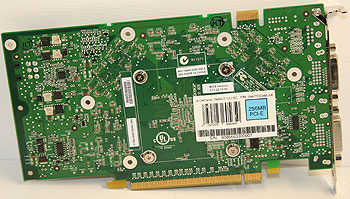eVGA e-GeForce 7900 GT CO Superclocked™ Board Exam
eVGA peddle what they call CO Superclocked™ versions of the base NVIDIA products they sell. Overclocked out-of-the-box, of course, eVGA bump the frequencies to make the product more attractive to the end user, increasing the price slightly over the plain version for the privilege.Their 7900 GT CO Superclocked™ therefore comes in at 550/790, not far off the reference GTX clocks of 650/800 and significantly higher than the standard GT frequencies of 450/660. Given the standard GT runs 800MHz-capable memory anyway and a 450MHz G71 isn't a hot runner, eVGA employ BIOS-level changes to get their Superclocked™ version up to 550/790.
And not only that, they use the reference cooler too. Check it out.
Board
The 256MiB of K4J55323QG-GC14 memory chips are all naked, uncooled by the cooler on the GPU, even at nearly 800MHz. We don't particularly like the cooler -- infact we think it's fairly obnoxious and worth changing -- but the rest of the board's form factor and environmentals do please. The PCB is pretty short and smaller than what carries the GTX.
It allows for simpler power regulation circuitry for the standard GT (compared to the GTX), but there's enough headroom in the design to accomodate something at eVGA's clocks. You can see the pair of DVI outputs (both of them dual-link) and the 6-pin power connector for feeding the board what the PCI Express 16X slot doesn't provide.
Lastly, you can see the SLI connector for running a pair of GTs together for even greater potential performance.
Bar eVGA's sticker, it's just standard GT stuff. The four screws for the cooler can be seen and the mounting holes for something a bit bigger (but unused) can be seen from the back of the board, as they can on the front.











